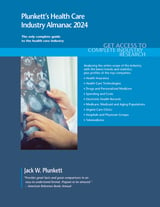 Health care expenditures continue to rise in the U.S. and throughout the world. Total U.S. health care expenditures were estimated to be $4.12 trillion in 2022 and are projected to soar to $5.51 trillion in 2030.
Health care expenditures continue to rise in the U.S. and throughout the world. Total U.S. health care expenditures were estimated to be $4.12 trillion in 2022 and are projected to soar to $5.51 trillion in 2030.
The health care market in the U.S. during 2023 was projected to include massive spending in the major categories of hospital care ($1,459 billion); dental, physician and clinical services ($930 billion); and prescription drugs ($411 billion), along with nursing home and home health care ($342 billion). Registered U.S. hospitals totaled 6,129 properties in 2023, according to an American Hospital Association survey, containing 919,649 beds.
Medicare, the U.S. federal government’s health care program for Americans 65 years or older, provided coverage to an estimated 66.6 million seniors during 2023. National expenditures on Medicare for fiscal 2023 were projected to be $1,019 billion, including premiums paid by beneficiaries and health care costs covered by Medicare. By 2030, the number of people covered by Medicare will balloon to about 76.8 million due to the massive number of Americans who will become of eligible age.
Medicaid is the federal government’s health care program for low-income and disabled persons (including qualified children), as well as certain groups of seniors in nursing homes. Enrollment in Medicaid and CHIP (Children’s Health Insurance Program) combined was estimated at 83.3 by Plunkett Research million for 2023. The majority of Medicaid/CHIP expenses were paid for by the federal government. However, the states pick up a significant share of the cost, which is a massive burden on state budgets.
Health spending in the U.S., at about 18% of Gross Domestic Product (GDP) in 2022, is projected to grow steadily. Health care spending in America accounts for a larger share of GDP than in any other country, by a wide margin. Despite the incredible investment America continues to make in health care, 7.9% of people in the U.S. (25.9 million) lacked health care coverage for at some point in 2022. For some, insurance was unavailable or unaffordable. In other cases, the lack of insurance was due to a personal decision not to pay for it. According to the Kaiser Family Foundation, most uninsured people are in low-income working families, but a large segment of those counted among America’s uninsured are non-U.S. citizens, both lawful and illegal residents.
In March 2010, President Obama signed the Patient Protection and Affordable Care Act (ACA), designed to strengthen insurance company regulation and provide medical coverage to millions of uninsured Americans. The act called for sweeping changes. Provisions taking effect within the first six months of signing included coverage for adult children up to age 26 on their parents’ policies; making it unlawful for insurers to place lifetime caps on payouts or deny coverage should a policy holder become ill; and new policies are required to pay the full cost of selected preventive care and exempt such care from deductibles. Small businesses with fewer than 25 employees and average annual wages of less than $50,000 became eligible for tax credits to cover up to 35% of staff insurance premiums.
Online health care insurance “exchanges” began enabling consumers to shop for health coverage. A 3.8% unearned income tax is levied on individuals earning more than $200,000 per year and families earning more than $250,000 per year, to fund the programs in the act. As of 2016, employers, with the equivalent of 50 full-time employees, which do not offer health benefits pay a fine per full time staff member if any of the workers receives a tax credit to buy coverage. A similar fine took effect in 2015 for employers with the equivalent of 100 full-time employees. Most businesses with more than 200 employees are required to enroll all staff automatically in health insurance plans. Consumers whose annual incomes do not exceed set amounts may receive federal financial assistance if they purchase their own health insurance.
Health Expenditures Globally and in OECD Developed Nations
A comprehensive study published by the Organization for Economic Cooperation & Development (OECD) covering more than 30 nations, including the majority of the world’s most developed economies (but excluding Brazil, Russia, India or China), found stark contrasts between health costs in the United States and those of other nations. In 2021 (the latest complete data available), the average of a list that includes, for example, the UK, France, Germany, Mexico, Canada, South Korea, Japan, Australia and the U.S., spent 9.7% of GDP (gross domestic product—a measure of a nation’s economy) on health care. The highest figures in this study were in America at 17.4% of GDP (which is actually a little low compared to U.S. government estimates), Germany at 12.9%, the UK at 12.4%, France at 12.3%, Canada at 12.3%, Austria at 12.1%, Switzerland at 11.8%, The Netherlands at 11.4%, Japan at 11.3%, Sweden at 11.2% and Portugal at 11.1%.
Total health care expenditures around the world are difficult to determine. However, $11.2 trillion would be a reasonable estimate for the formal, global health care market for 2022. That would place health care at roughly 11.2% of global GDP and about $1,485 in health spending per person on average. In the U.S. and other developed nations, the per capita number is much higher. The federal government forecast 2022 spending at $12,407 per capita for 2022. The trend over the near future is for the modest amount now spent on health care in emerging nations to rise dramatically, while OECD nations like America struggle to contain their own mountainous costs. Globally, the total prescription drug market was $1.4 trillion in 2022.
Rising Health Care Costs in the U.S.
Particularly in the U.S., continuous increases in the cost of health care, growing at rates far exceeding the rate of inflation in general, have been inflicting financial pain on health consumers and payers of all types. Government agencies are strained by the ever-growing cost of public health care programs such as Medicare, while employers are hit hard by vast increases in the cost of providing coverage to employees and retirees.
Many major employers are utilizing unique new programs in efforts to reduce employee illness, and thereby cut costs. For example, the use of preventive care programs is growing, as is the use of employee education aimed at better managing the effects of diseases such as diabetes. Some very large employers are even hiring in-house physicians and nurses, or contracting with outside providers for on-premises care facilities, to offer primary and preventive care in the workplace.
Patients and insurance companies are also dealing with sticker shock over the nation’s prescription drug costs. Other factors edging costs upward include expensive new medical technologies and patients’ demands for greater flexibility in choosing doctors and specialists at their own discretion. At the same time, hospitals and health systems write off massive amounts of potential revenues to bad debt, which increases costs for bill-paying patients.
In the wake of the tremendous growth of all aspects of the health care industry from the end of World War II onward, efficiency, competition, price transparency and productivity were, regretfully, largely overlooked. Much of this occurred because employers, plus federal and state governments, pay such a large portion of the health care bill, to the extent that patients were generally not sensitive to health care costs.
The Centers for Disease Control and Prevention (CDC) reported recently that six in ten Americans suffer with at least one chronic disease such as cancer, diabetes, heart disease, pulmonary conditions, stroke or hypertension. In addition to the massive cost of health care for these patients, the lost time at work and lost economic output due to these illnesses substantially reduced the nation’s GDP. These burdens could be vastly reduced through better consumer health practices and better preventive medicine. For example, obesity, lack of exercise and cigarette smoking are immense contributors to these diseases. The CDC reported that medical costs for obesity-related diseases (which affect 20% of children and 42% of adults) rose as high as $173 billion in 2021, compared to $74 billion in 1998.
Where to Learn More
 This article is an excerpt from a newly published report Plunkett's Health Care Industry Almanac 2024: Health Care Industry Market Research, Statistics, Trends and Leading Companies, which covers competitive intelligence, market research and business analysis—everything you need to know about the health care industry.
This article is an excerpt from a newly published report Plunkett's Health Care Industry Almanac 2024: Health Care Industry Market Research, Statistics, Trends and Leading Companies, which covers competitive intelligence, market research and business analysis—everything you need to know about the health care industry.
Use this report to quickly understand major industry trends, access key industry statistics, and gain an understanding of top competitors in this space. Visit the report page using the link above to learn more.
Additional Health Care Market Research Reports
- Hospitals (U.S.): Analytics, Extensive Financial Benchmarks, Metrics and Revenue Forecasts to 2030
- Medical Equipment and Supplies Manufacturing (U.S.): Analytics, Extensive Financial Benchmarks, Metrics and Revenue Forecasts to 2030
About Plunkett Research, Ltd
Plunkett Research, Ltd. is a leading publisher of business and industry research, with a global client list of top corporations, consultancies, investment firms, universities and government agencies. Our core focus is on the analysis of industry trends, industry benchmarks, technologies and opportunities. This allows us to leverage our research methodology to deliver accurate, timely information that our clients need to develop business strategies, determine market scope and consider investment opportunities.
With Permission
Copyright © 2024, Plunkett Research, Ltd., All Rights Reserved

